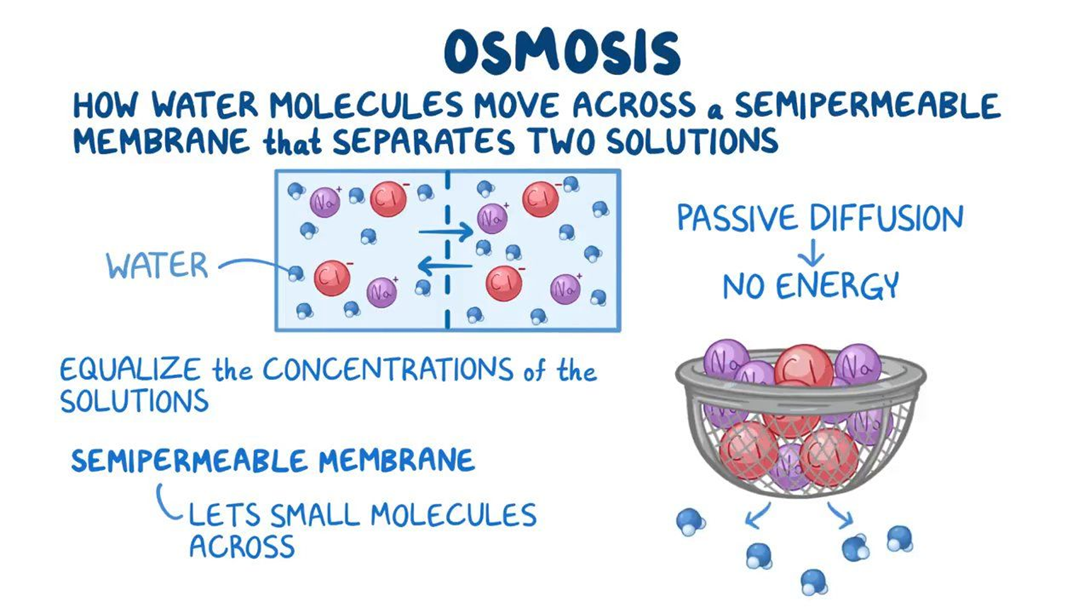Fluid and electrolyte balance is maintained through the process of fluid and solutes moving in and out of cells. What specific process allows fluid to pass through a membrane from a dilute to a more concentrated area?
Active transport
Osmosis
Filtration
Diffusion
The Correct Answer is B
Choice A reason: Active transport is not the process that allows fluid to pass through a membrane from a dilute to a more concentrated area. Active transport is the process that moves solutes across a membrane against their concentration gradient, using energy from ATP. Active transport can create or maintain a concentration difference between two sides of a membrane.
Choice B reason: Osmosis is the process that allows fluid to pass through a membrane from a dilute to a more concentrated area. Osmosis is the movement of water across a selectively permeable membrane from an area of low solute concentration to an area of high solute concentration. Osmosis can equalize the concentration of solutes on both sides of a membrane.
Choice C reason: Filtration is not the process that allows fluid to pass through a membrane from a dilute to a more concentrated area. Filtration is the movement of fluid and solutes across a membrane due to a pressure difference between two sides of a membrane. Filtration can separate solutes from fluid based on their size and charge.
Choice D reason: Diffusion is not the process that allows fluid to pass through a membrane from a dilute to a more concentrated area. Diffusion is the movement of solutes across a membrane from an area of high solute concentration to an area of low solute concentration. Diffusion can also equalize the concentration of solutes on both sides of a membrane.

Nursing Test Bank
Naxlex Comprehensive Predictor Exams
Related Questions
Correct Answer is B
Explanation
Choice A reason: Active transport is the process of moving molecules across a cell membrane against a concentration gradient, requiring energy.
Choice B reason: Diffusion is the process of moving molecules from an area of high concentration to an area of low concentration, without using energy.
Choice C reason: Filtration is the process of moving fluid and solutes through a membrane by a pressure gradient.
Choice D reason: Osmosis is the process of moving water across a semipermeable membrane from an area of low solute concentration to an area of high solute concentration.
Correct Answer is B
Explanation
Choice A reason: MRI is not a diagnostic procedure for Barrett esophagus. MRI is a type of imaging test that uses magnetic fields and radio waves to create detailed pictures of the internal organs and tissues. It is mainly used to diagnose problems in the brain, spine, joints, and blood vessels.
Choice B reason: EGD is a diagnostic procedure for Barrett esophagus. EGD is a type of endoscopy that uses a flexible tube with a light and a camera to examine the esophagus, stomach, and duodenum. It can detect changes in the lining of the esophagus that may indicate Barrett esophagus, a condition where the normal squamous cells are replaced by columnar cells due to chronic acid exposure.
Choice C reason: Colonoscopy is not a diagnostic procedure for Barrett esophagus. Colonoscopy is a type of endoscopy that uses a flexible tube with a light and a camera to examine the colon and rectum. It is mainly used to screen for colorectal cancer and polyps, as well as to diagnose inflammatory bowel disease and other conditions affecting the lower gastrointestinal tract.
Choice D reason: CT scan is not a diagnostic procedure for Barrett esophagus. CT scan is a type of imaging test that uses X-rays and a computer to create cross-sectional pictures of the body. It is mainly used to diagnose problems in the chest, abdomen, pelvis, and bones.
Whether you are a student looking to ace your exams or a practicing nurse seeking to enhance your expertise , our nursing education contents will empower you with the confidence and competence to make a difference in the lives of patients and become a respected leader in the healthcare field.
Visit Naxlex, invest in your future and unlock endless possibilities with our unparalleled nursing education contents today
Report Wrong Answer on the Current Question
Do you disagree with the answer? If yes, what is your expected answer? Explain.
Kindly be descriptive with the issue you are facing.
